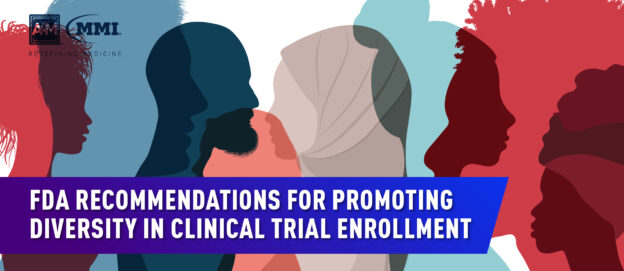Over the past few decades, the United States Food and Drug Administration (FDA) has been actively working to promote inclusive enrollment practices aimed at making clinical trials more reflective of the general population; they have also focused on including a larger proportion of demographics most likely to use the medications if approved. Despite broadening eligibility criteria, challenges to participation in clinical trials remain as does widespread under-representation of several racial demographics.
Updated Enrollment Guidance
To further promote inclusivity practices, the FDA recently released updated guidance that recommends encouraging drug and biologic sponsors to broaden enrollment criteria to avoid unnecessarily excluding participants in final guidance document aimed at increased diversity of clinical trial participants.
In the guidance issued on November 9, 2020, sponsors are encouraged to include individuals of different demographics – sex, race, ethnicity, age, and location – and those with other non-demographic characteristics, such as rare diseases, comorbid conditions, and disabilities.
Additionally, the agency pointed out that patients who were commonly excluded in the past – such as older adults, children, patients at extremes of the weight range, and those with malignancies and HIV – are often left out without a strong clinical or scientific justification. In an effort to promote and protect public health, the agency hopes to make sure participants of clinical trials best represent the populations most likely to utilize the products.
“Unnecessary exclusion of such participants may lead to a failure to discover important safety information about use of the investigational drug in patients who will take the drug after approval,” the agency wrote in the final guidance. “Therefore, broadening eligibility criteria in later stages of drug development for the phase 3 population increases the ability to understand the therapy’s benefit-risk profile across the patient population likely to use the drug in clinical practice.”
Inclusive Trial Practices
The new FDA guidance suggests employing inclusive trial practices, such as considering each exclusion criterion individually to determine if it is necessary to ensure safety and achieve study objectives. Nonetheless, some patients may still need to be excluded from trials due to the risk of adverse events outweighing potential benefits for the individual. In other cases, there should be fewer exclusions made even among medically complex patients, those using concomitant medications, and those with comorbidities – unless the trial could endanger their health.
Additionally, sponsors can consider eliminating or modifying certain exclusion criteria as the clinical trial moves to phase 3, altering protocols from phase 2. The FDA suggests sponsors include children and young adults in confirmatory clinical trials that involve adults, enroll enough women in a trial to allow detection of sex-related differences; including racial and ethnic minorities to identify population specific variables .
Promoting Participation
Other non-clinical factors can be considered to broaden trial enrollment, such as making participation less burdensome for subjects. The FDA’s updated guidance includes more emphasis on real-world data which can be obtained by sending medical professionals to visit trial participants instead of requiring participant travel. Sponsors are encouraged to reduce visit frequency when appropriate, consider flexibility in visit window scheduling, and use electronic communications – such as phone, email, social media platforms, and other digital technologies – in place of site visits. In addition, the FDA also recommends locating trial sites in places with higher concentrations of racial and ethnic minorities and selecting healthcare providers and study coordinators that reflect the diversity being sought among participants.
Participants with Rare Diseases
As part of updated recommendations, the FDA recognized that designing trials for rare diseases and conditions presents a unique challenge. “Because rare diseases often affect small, geographically dispersed patient populations with disease-related travel limitations, special efforts may be necessary to enroll and retain these participants to ensure that a broad spectrum of the patient population is represented,” the agency wrote.
They recommend sponsors work on rare disease treatments by engaging patient advocacy groups, experts, and patients early on in the process and launching open-label extension studies with broader inclusion criteria. Sponsors can also consider re-enrolling participants from early-phase trials in later-phase trials, if the therapy used in phase 1 is not expected to change the course of their disease.
With racial and ethnic minorities affected differently by COVID-19, the pandemic has further emphasized racial healthcare disparities and the need for more equitable standards across the industry. Differences in patient outcomes and medication tolerability among other factors highlight the need for more inclusive clinical trial organization. Above all, developers of medical products, treatments, and vaccines must include diverse populations in order to understand the risks and benefits, safety, and efficacy of their products across populations.

